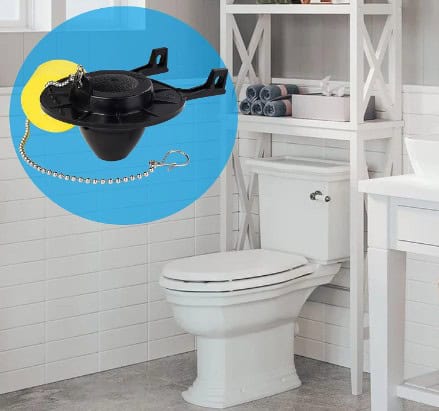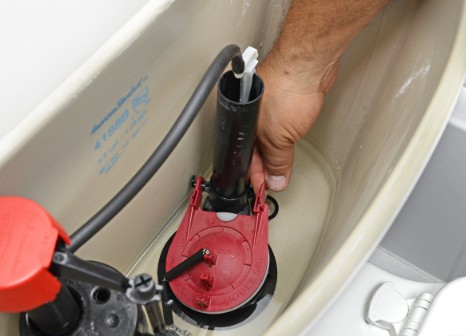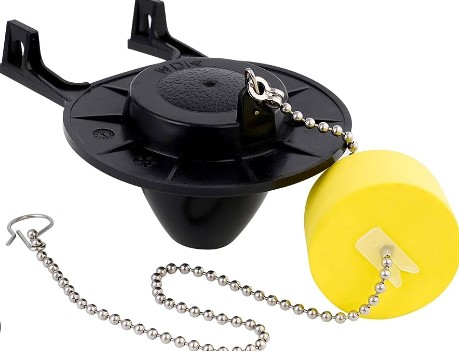Considering how integral a toilet flapper is, serving the primary function of regulating the release of water from the toilet tank into the toilet bowl during a flush, it must work flawlessly.
However, things don’t last forever, so what American Standard toilet flapper problems can owners of this toilet encounter?
American Standard toilet flapper can develop leaks, chain issues, or deteriorate over time. Moreover, it can get stuck, fail to seal correctly, or float, thus interfering with the flush operation.
You must address these issues to avoid problems like incomplete flushing, constant running, tank refilling issues, and reduced water efficiency. With that said, check out the causes and solutions for American Standard toilet flapper problems below.

American Standard Toilet Flapper Problems (Causes & Fixes!)
| Problem | Possible Causes | Recommended Fixes | |
| 1. | Flapper Leaks | Wear and tear due to prolonged use | Replace the leaking flapper |
| 2. | Flapper Chain Issues | The chain is excessively long or too short | Adjust the length of the chain to achieve proper slack |
| 3. | Flapper Not Sealing Properly | The flapper is misaligned over the flush valve seat Debris or mineral deposit accumulation Worn out flapper | Realign the flapper Clean the flapper and flush valve seat Clean the flapper and flush valve seat Replace the damaged flapper |
| 4. | Flapper Sticking | Obstructions in the flush handle or flapper mechanism Warped or damaged flapper Debris or rough edges on the flapper or flush valve seat Tangled or caught flapper chain | Remove any obstructions Replace a damaged flapper Sand or smooth rough edges Ensure the flapper chain is unobstructed or tangled |
| 5. | Deterioration | Prolonged water and chemical exposure | Install a new replacement toilet flapper |
| 6. | Flapper Floats | The water level is set too high | Adjust the tank’s water level |
| 7. | Incompatible Flapper | Using the wrong toilet flapper | Install a toilet flapper compatible with your American Standard toilet |
1. Flapper Leaks
Over time, even a well-maintained flapper will deteriorate, leading to leaks, so expect your American Standard toilet flapper to wear out. A leaking flapper can cause your toilet to run continuously or intermittently, wasting water and potentially leading to higher water bills.
If a constant trickling sound is continuously coming from your toilet, the flapper is likely malfunctioning, causing leaks.
Fix
- Replace your toilet flapper if it shows signs of wear or is old. Consider getting the American Standard 7381129-200.0070A Universal Flapper (View on Amazon) with a chain and float if you have a 2-inch flush valve. It’s durable, reliable, and easy to install.
2. Flapper Chain Issues
Your toilet will run continuously if the flapper chain is too long because that can keep the flapper from sealing correctly. This allows water to continuously flow from the tank into the bowl, causing that annoying sound of water running and potentially wasting a significant amount of water over time.
On the flip side, the flapper may fail to close completely after flushing if the chain is too tight. This can result in an incomplete flush, leaving waste behind and requiring a second flush.
Therefore, keeping your flapper chain at the right length is imperative to ensure efficient flapper functioning.
Fix
- You’ll want to add some slack if the chain is too loose. To do this, simply unhook the chain from the flush lever or handle and reattach it to a different hole or link on the chain. Experiment with different positions until you achieve the desired amount of slack. Ideally, there should be a little bit of slack when the flapper is closed, allowing it to seal tightly.
- Conversely, you’ll need to create more slack if the chain is too tight. Unhook the chain and locate the chain’s adjustment clip. This clip allows you to lengthen or shorten the chain. Slide the clip to a position that provides enough slack to allow the flapper to open fully when you flush the toilet.
Note
Inspect the flapper chain to determine its condition. If it is rusty or corroded, replace it with a new chain.
After all, chains are readily available and inexpensive. For instance, Toilet Handle Chain Stainless Steel Toilet Flapper Lift Chain Replacement (View on Amazon) is long-lasting, practical, easy to install, and a universal fit for a majority of flappers.
3. Flapper Not Sealing Properly
You must ensure your toilet flapper seals properly; otherwise, water will flow into your toilet bowl nonstop, causing the toilet to run intermittently. Your toilet flapper may fail to seal well because it is misaligned against the flush valve seat, damaged, or covered by dirt or mineral deposits.
So, what should you do if you encounter a situation where your American Standard toilet flapper isn’t sealing correctly? Below is the recommended fix.
Fix
Ensure the flapper is properly aligned over the flush valve seat because it won’t create a tight seal if it’s misaligned. Adjust the flapper’s positioning, and make sure it covers the flush valve opening completely.
Also, check for debris or mineral buildup on the flush valve seat and the flapper itself. Clean these surfaces thoroughly to ensure a proper seal.
If the flapper isn’t sealing because it is worn out, replace it with a new one designed for your American Standard toilet model.

4. Sticking Flapper
Sometimes, the flapper can stick to the flush valve seat, preventing it from opening and closing smoothly. Alternatively, it can remain open at all times, causing the toilet to run continuously.
Fix
- Remove any obstructions in the flush handle or flapper mechanism if your flapper is stuck open.
- Replace a warped or damaged flapper.
- Inspect the flapper and flush valve seat for any rough edges or debris that may be causing sticking. If you find any, carefully sand or smooth these areas to ensure the flapper moves freely.
- Additionally, check the chain to make sure it’s not tangled or caught on anything that could impede the flapper’s movement.
5. Flapper Floats
A floating toilet flapper can interfere with the flush operation, reducing flushing efficiency and incomplete waste removal. When the flapper remains buoyant, it may not seal appropriately after a flush, causing continuous leaking.
Your American Standard toilet flapper is likely floating if the toilet runs constantly, delivers an incomplete flush, or the water level in the tank appears unusually high.
Fix
Adjust the tank’s water level using the adjustment screw on the fill valve to ensure it’s not too high. Lowering the water level should prevent the flapper from floating, but do not set it too low, as that can reduce the effectiveness of the flush.
Also, ensure the chain connecting the flapper to the flush lever is appropriately adjusted to allow some slack.
6. Incompatible Flapper
American Standard toilets are designed with specific flapper models in mind, and using the wrong flapper can disrupt the flushing mechanism. An incompatible flapper can cause various problems, including poor flushing performance and constant water leaks.
Use a flapper designed for your toilet or a universal flapper to ensure optimal performance. A compatible flapper fits and functions correctly with American Standard flush valves, providing a proper seal.
However, should you find out that your American Standard toilet has an incompatible flapper, you can still fix the issue.
Fix
Purchase a replacement flapper that matches the flush valve type in your American Standard toilet. If you’re unsure about the correct flapper model, bring the old one for reference.
7. Flapper Deterioration
Your toilet flapper will inevitably wear out after using it for a while. Over time, exposure to water and chemicals can cause the flapper in your American Standard toilet to deteriorate, leading to cracks, warping, stiffness, or other forms of damage.
Before fixing this issue, determine whether the flapper has indeed deteriorated by looking for the following signs:
- Visible Damage: Examine the flapper for cracks, warping, or any signs of physical damage. Even tiny cracks can significantly affect its sealing ability.
- Stiffness: A deteriorated flapper may become stiff or rigid, making it less effective at creating a proper seal.
- Wear and Tear: Check for signs of wear and tear, such as worn edges or areas that have lost their flexibility.
Fix
After confirming that your American Standard toilet flapper is indeed worn out, replace it.

How To Replace A Worn-Out American Standard Flapper
Take these steps to install a replacement American Standard toilet flapper
- Turn Off the Water Supply
Turn the shut-off valve located near the toilet base clockwise to stop water flow. This will ensure water doesn’t flow while you work on the flapper.
- Remove the Tank Lid
Carefully lift the tank lid off your toilet and set it aside in a safe location.
- Identify the Flapper
Locate the flapper (the rubber or plastic valve covering the opening of the flush valve opening) inside the tank.
- Remove the Old Flapper
Disconnect the flapper from its mounting points. Depending on the model of your American Standard toilet, this may involve unhooking a chain or removing clips.
Follow the manufacturer’s instructions if you’re unsure.
- Choose a Replacement Flapper
Before purchasing a replacement flapper, check your toilet’s model and flush valve type. American Standard offers various flapper designs to match specific toilet models.
Choose a flapper compatible with your toilet to ensure a proper fit.
- Install the New Flapper
To install a new flapper, you typically attach it to the flush valve seat and connect any necessary chains or clips. However, don’t go in mindlessly; instead, let the manufacturer’s instructions guide you to ensure you get the installation right.
- Turn On the Water Supply
Restore water flow by rotating the shut-off valve counterclockwise. Allow the tank to fill, then flush the toilet to ensure the new flapper seals correctly and that there are no leaks.
- Perform a Leak Test
Conduct a leak test to confirm that the new flapper is sealing correctly. Put some food coloring inside the tank, and don’t flush for around 10 minutes.
If you notice colored water in the bowl, the flapper is not sealing properly, and you may need to adjust or reinstall it.
Final Remarks on American Standard Toilet Flapper Problems
Flapper problems are common, but with the right knowledge and maintenance, you can keep your American Standard toilet running smoothly for years to come. Consequently, this post will help you troubleshoot your toilet if you encounter flapper issues.
Also, Read:
